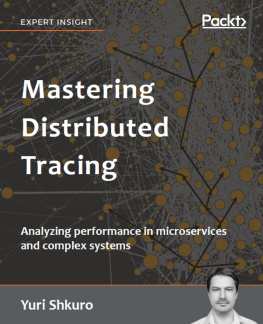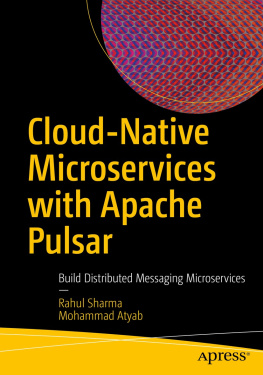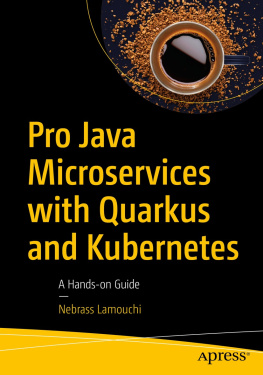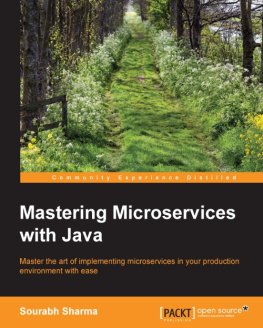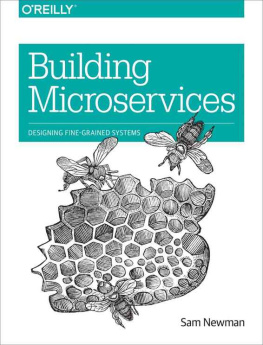Yuri Shkuro - Mastering Distributed Tracing: Analyzing performance in microservices and complex systems
Here you can read online Yuri Shkuro - Mastering Distributed Tracing: Analyzing performance in microservices and complex systems full text of the book (entire story) in english for free. Download pdf and epub, get meaning, cover and reviews about this ebook. year: 2019, publisher: Packt Publishing, genre: Computer. Description of the work, (preface) as well as reviews are available. Best literature library LitArk.com created for fans of good reading and offers a wide selection of genres:
Romance novel
Science fiction
Adventure
Detective
Science
History
Home and family
Prose
Art
Politics
Computer
Non-fiction
Religion
Business
Children
Humor
Choose a favorite category and find really read worthwhile books. Enjoy immersion in the world of imagination, feel the emotions of the characters or learn something new for yourself, make an fascinating discovery.
- Book:Mastering Distributed Tracing: Analyzing performance in microservices and complex systems
- Author:
- Publisher:Packt Publishing
- Genre:
- Year:2019
- Rating:5 / 5
- Favourites:Add to favourites
- Your mark:
- 100
- 1
- 2
- 3
- 4
- 5
Mastering Distributed Tracing: Analyzing performance in microservices and complex systems: summary, description and annotation
We offer to read an annotation, description, summary or preface (depends on what the author of the book "Mastering Distributed Tracing: Analyzing performance in microservices and complex systems" wrote himself). If you haven't found the necessary information about the book — write in the comments, we will try to find it.
Yuri Shkuro: author's other books
Who wrote Mastering Distributed Tracing: Analyzing performance in microservices and complex systems? Find out the surname, the name of the author of the book and a list of all author's works by series.
Mastering Distributed Tracing: Analyzing performance in microservices and complex systems — read online for free the complete book (whole text) full work
Below is the text of the book, divided by pages. System saving the place of the last page read, allows you to conveniently read the book "Mastering Distributed Tracing: Analyzing performance in microservices and complex systems" online for free, without having to search again every time where you left off. Put a bookmark, and you can go to the page where you finished reading at any time.
Font size:
Interval:
Bookmark:

Copyright 2019 Packt Publishing
All rights reserved. No part of this book may be reproduced, stored in a retrieval system, or transmitted in any form or by any means, without the prior written permission of the publisher, except in the case of brief quotations embedded in critical articles or reviews.
Every effort has been made in the preparation of this book to ensure the accuracy of the information presented. However, the information contained in this book is sold without warranty, either express or implied. Neither the author, nor Packt Publishing or its dealers and distributors, will be held liable for any damages caused or alleged to have been caused directly or indirectly by this book.
Packt Publishing has endeavored ...
Did you know that Packt offers eBook versions of every book published, with PDF and ePub files available? You can upgrade to the eBook version at > for more details.
At www.Packt.com, you can also read a collection of free technical articles, sign up for a range of free newsletters, and receive exclusive discounts and offers on Packt books and eBooks.
Yuri Shkuro is a software engineer at Uber Technologies, working on distributed tracing, observability, reliability, and performance. He is the technical lead for Uber's tracing team. Before Uber, Yuri spent 15 years on Wall Street, building trading and risk management systems for derivatives at top investment banks, Goldman Sachs, JPMorgan Chase, and Morgan Stanley.
Yuri's open source credentials include being a co-founder of the OpenTracing project, and the creator and the tech lead of Jaeger, a distributed tracing platform developed at Uber. Both projects are incubating at the Cloud Native Computing Foundation. Yuri serves as an invited expert on the W3C Distributed Tracing working group.
Dr. Yuri Shkuro holds a ...
Pavol Loffay is a software engineer at Red Hat working on Observability tools for microservice architectures. He is an active maintainer of the Jaeger and OpenTracing projects. He is also a member of the OpenTracing Specification Council ( OTSC ) and a lead for the MicroProfile OpenTracing specification. In his free time, Pavol likes to travel and he is a passionate skier and rock climber.
Lev Polyakov is an award winning independent animation director and conceptual artist, whose films were featured on WNET 13, Channel Frederator, and ShortsHD.
Lev Polyakov has been active in the animation world since 2004, starting as an intern for Signe Baumane, one of New York's most prominent independent animators, and proceeding to write and direct his own animated films. His first short, Piper the Goat and the Peace Pipe , won the first place at the 2005 Ottawa Animation Festival. For his next film, Morning, Day, Evening, Night and Morning Again, Lev was awarded a grant and an honorary membership from the National Board of Review of Motion Pictures. During his junior year at School of Visual Arts, Lev directed and produced ...
If you're interested in becoming an author for Packt, please visit authors.packtpub.com and apply today. We have worked with thousands of developers and tech professionals, just like you, to help them share their insight with the global tech community. You can make a general application, apply for a specific hot topic that we are recruiting an author for, or submit your own idea.
Distributed tracing, also known as end-to-end tracing, while not a new idea, has recently began receiving a lot of attention as a must-have observability tool for complex distributed systems. Unlike most other tools that only monitor individual components of the architecture, like a process or a server, tracing plays a rather unique role by being able to observe end-to-end execution of individual requests, or transactions, following them across process and network boundaries. With the rise of such architectural patterns as microservices and functions-as-a-service (or FaaS, or serverless), distributed tracing is becoming the only practical way of managing the complexity of modern architectures.
The book you are about to read is based on ...
, Introduction , provides a general introduction to the area of distributed tracing.
, Why Distributed Tracing , frames the observability problem that distributed tracing aims to solve and explains why other monitoring tools fall short when it comes to troubleshooting pathological behavior in complex distributed systems. The chapter includes a brief history of my personal experience with tracing and an explanation of why I felt that writing this book would be a useful contribution to the industry.
, Take Tracing for a HotROD Ride , dives in with an easy to run, hands-on example used to illustrate the core features, benefits, and capabilities of distributed tracing, using Jaeger, an open source tracing platform, the OpenTracing instrumentation, and a demo application HotROD (Rides on Demand).
, Distributed Tracing Fundamentals , reviews the basic operating principles of end-to-end tracing, such as causality tracking and metadata propagation, and various design decisions historically taken by different implementations that affect the types of problems a given tracing architecture is able to solve. It introduces the reader to two different tracing models, the more expressive event model, and more popular span model.
, Data Gathering Problem , is dedicated to discussions about the different ways of getting tracing data out of the applications, through manual and automatic (agent-based) instrumentation, for both RPC-style and asynchronous (for example, using message queues) applications.
, Instrumentation Basics with OpenTracing , provides a step-by-step guide of manually instrumenting a simple "hello, world" style application for tracing, as it is being evolved from a monolith to a microservices-based system. Three parallel sets of examples are provided in popular programming languages: Go, Java, and Python. The chapter teaches the fundamentals of tracing instrumentation using the OpenTracing API; however, the general patterns are applicable to other instrumentation APIs as well. In the final exercises the chapter introduces automatic (agent-based) instrumentation style that requires little, if any, actual code changes in the application.
, and applies them to an "online chat" type of application built around asynchronous messaging using Apache Kafka.
, Tracing Standards and Ecosystem , explores the often confusing ecosystem of the tracing industry at large, including the emerging standards such as OpenTracing, W3C Trace Context, and OpenCensus. It provides a useful taxonomy of how to think about the different commercial and open source projects and their positions in relation to each other.
, Tracing with Service Mesh , uses the service mesh Istio, running on Kubernetes, to trace an application and compare the results with tracing an application that is natively instrumented for tracing via the OpenTracing API. It reviews the pros and cons of each approach.
, All About Sampling
Font size:
Interval:
Bookmark:
Similar books «Mastering Distributed Tracing: Analyzing performance in microservices and complex systems»
Look at similar books to Mastering Distributed Tracing: Analyzing performance in microservices and complex systems. We have selected literature similar in name and meaning in the hope of providing readers with more options to find new, interesting, not yet read works.
Discussion, reviews of the book Mastering Distributed Tracing: Analyzing performance in microservices and complex systems and just readers' own opinions. Leave your comments, write what you think about the work, its meaning or the main characters. Specify what exactly you liked and what you didn't like, and why you think so.

